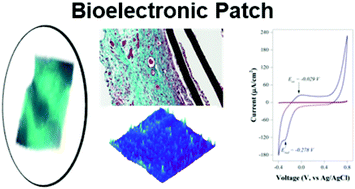A flexible polyaniline-based bioelectronic patch†
Abstract
Bioelectronic materials based on conjugated polymers are being developed in the hope to interface with electroresponsive tissues. We have recently demonstrated that a polyaniline chitosan patch can efficiently electro-couple with cardiac tissue modulating its electrophysiology. As a promising bioelectronic material that can be tailored to different types of devices, we investigate here the impact of varying the synthesis conditions and time of the in situ polymerization of aniline (An) on the sheet resistance of the bioelectronic patch. The sheet resistance increases significantly for samples that have either the lowest molar ratio of oxidant to monomer or the highest molar ratio of dopant to monomer, while the polymerization time does not have a significant effect on the electrical properties. Conductive atomic force microscopy reveals that the patch with the lowest sheet resistance has a connected network of the conductive phase. In contrast, patches with higher sheet resistances exhibit conductive areas of lower current signals or isolated conductive islands of high current signals. Having identified the formulation that results in patches with optimal electrical properties, we used it to fabricate patches that were implanted in rats for two weeks. It is shown that the patch retains an electroactive nature, and only mild inflammation is observed with fibrous tissue encapsulating the patch.



 Please wait while we load your content...
Please wait while we load your content...